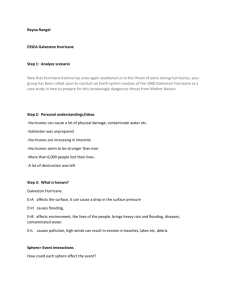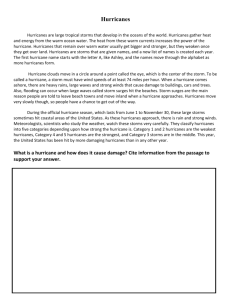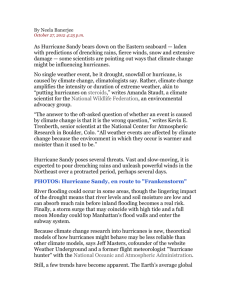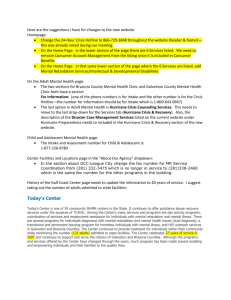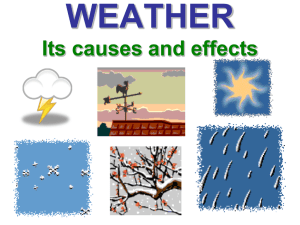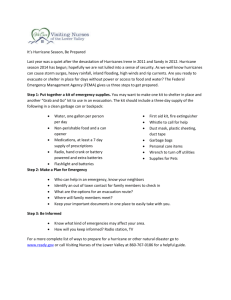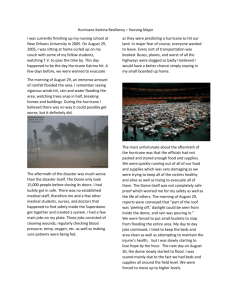PBL/ESS Team 1 Hurricane of 1900
advertisement
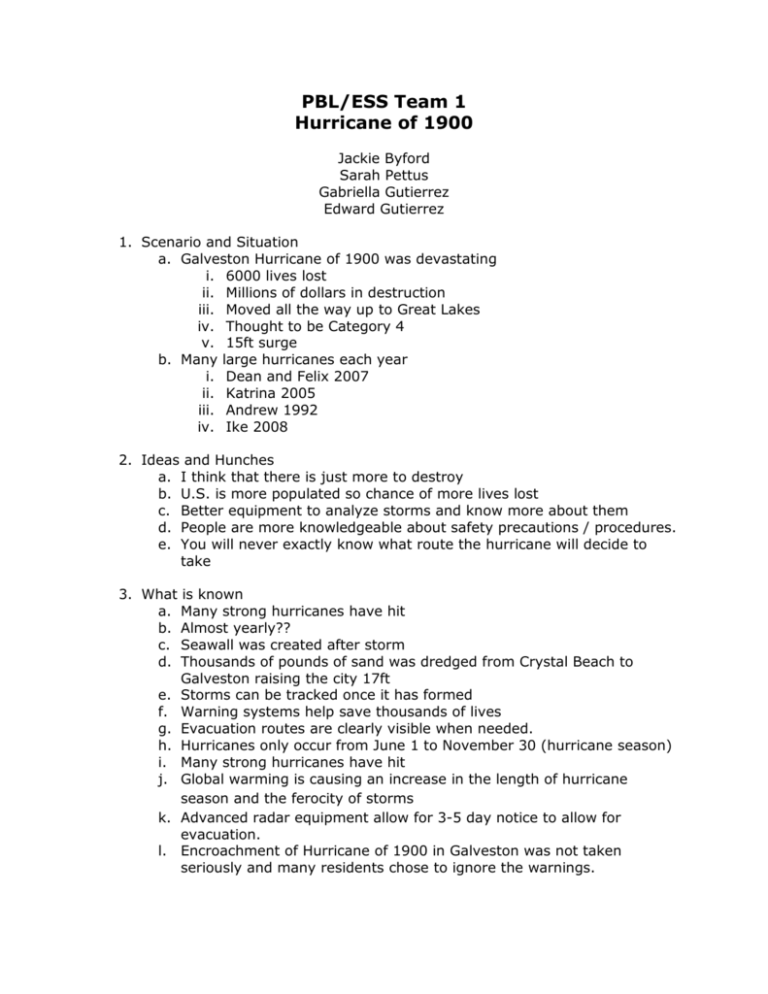
PBL/ESS Team 1 Hurricane of 1900 Jackie Byford Sarah Pettus Gabriella Gutierrez Edward Gutierrez 1. Scenario and Situation a. Galveston Hurricane of 1900 was devastating i. 6000 lives lost ii. Millions of dollars in destruction iii. Moved all the way up to Great Lakes iv. Thought to be Category 4 v. 15ft surge b. Many large hurricanes each year i. Dean and Felix 2007 ii. Katrina 2005 iii. Andrew 1992 iv. Ike 2008 2. Ideas and Hunches a. I think that there is just more to destroy b. U.S. is more populated so chance of more lives lost c. Better equipment to analyze storms and know more about them d. People are more knowledgeable about safety precautions / procedures. e. You will never exactly know what route the hurricane will decide to take 3. What is known a. Many strong hurricanes have hit b. Almost yearly?? c. Seawall was created after storm d. Thousands of pounds of sand was dredged from Crystal Beach to Galveston raising the city 17ft e. Storms can be tracked once it has formed f. Warning systems help save thousands of lives g. Evacuation routes are clearly visible when needed. h. Hurricanes only occur from June 1 to November 30 (hurricane season) i. Many strong hurricanes have hit j. Global warming is causing an increase in the length of hurricane season and the ferocity of storms k. Advanced radar equipment allow for 3-5 day notice to allow for evacuation. l. Encroachment of Hurricane of 1900 in Galveston was not taken seriously and many residents chose to ignore the warnings. m. Insufficient warning system, two brothers rode by horse back to try to warn the residents. n. Residents did not know about the danger of pressure and implosion of their homes and subsequently may have caused more damage by leaving their windows shut. o. Galveston was raised 17 feet to protect the island from flooding following the hurricane in addition to the 10 ft tall sea wall. 4. What is unknown a. Exactly how many storms are hitting the coast in the past few decades compared to the early 1900’s. b. Are the hurricanes in the past years stronger that hurricanes of the past? c. Is lack of radar and meteorological equipment to blame for not giving the people of 1900 warning? d. Was lack of understanding how a hurricane works a factor to loss of lives? e. Were they aware the hurricane was coming? f. How were the bodies disposed? g. What caused the hurricane to go that route? h. What instruments are used to predict hurricanes? i. How did they predict hurricanes in the 1900s? j. Could the seawall protect them from another category 4 hurricane? 5. What needs to be done a. Comparison of Named storms that hit Texas Gulf i. Category ii. Exact place hit iii. Year iv. Destruction and live lost 1. Storm 1 Carla, Category 5, Corpus Christi 1961 2. Storm 2 Audrey, Category 4, Port Arthur, 1957 3. Rita, Category 3, Port Arthur, 2005 6. Problem statement a. The Galveston Hurricane of 1900 was a devastating Hurricane that the people were not prepared for. Many strong Hurricanes have hit the coast of Texas over the past two decades. Is the Texas coast experiencing more intense storms than in the early 1900’s? E>A A hurricane brings strong winds pulling debris into the atmosphere. Moisture in the atmosphere may cause downpours. The gases emitted by the people and animal remains affect the atmosphere. E>H Water from the ocean is pulled into the atmosphere and deposited in other parts of the ocean and on land. The amount of rain deposited into the streets causing flooding. The debris left over from the hurricane can end up in rivers and oceans Rivers may overflow and cause major flooding. E>L The winds from the hurricane pulls up trees, plants, and anything in its path moving sand and dirt to unwanted areas. Debris is added to the sand and dirt changing the composition of the soils. Erosion damages sand dunes. The topsoil was destroyed by the water levels left by the Galveston hurricane. E>B Before it hits people have to prepare by boarding windows and tying down property. Many people have to pack up and evacuate leaving their possession behind not knowing if they will be there in return. The wind and rain of the hurricane carry debris that can harm anyone outside during the event. The strong winds and rain killed many plants, animals, and people. Increase of insects and bacteria. A>E Air currents and temperature help to form hurricanes. H>E The warm water of the ocean and gulf tend to increase the strength of the storm. L>E The destruction of the lithosphere from past hurricanes can mix up with present hurricanes and increase their destruction path. B>E The release of carbon into the atmosphere creating greenhouse gases cause more intense storms and increase the amount of storms yearly. Things that get go through the hurricane’s path will decrease the hurricane’s potential. 7. Gather information: possible websites to study a. http://www.nhc.noaa.gov/ b. http://www.ready.gov/hurricanes c. http://www.redcross.org/prepare/disaster/hurricane d. http://www.accuweather.com/en/hurricane e. http://www.deadlystorms.com/storms/1900/1900%20Galveston/obser vations.htm f. http://www.texasgulfcoastonline.com/news/tabid/86/ctl/articleview/mi d/466/articleid/117/default.aspx g. http://www.cccarto.com/gulfcoast_hurricanes/index.html 8. Present findings
